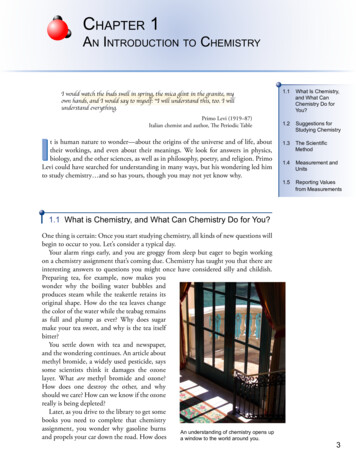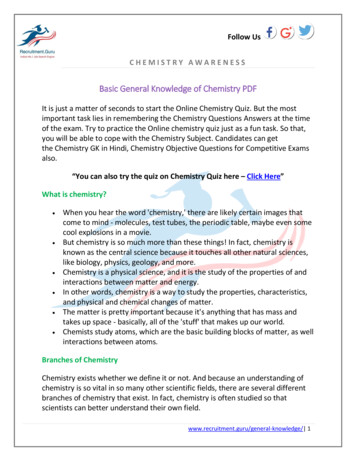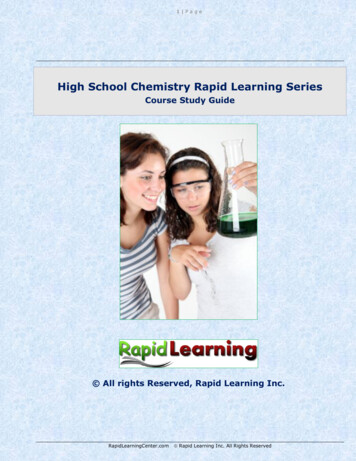
Transcription
Chapter 1An Introduction to ChemistryI would watch the buds swell in spring, the mica glint in the granite, myown hands, and I would say to myself: “I will understand this, too. I willunderstand everything.Primo Levi (1919–87)Italian chemist and author, The Periodic Tablet is human nature to wonder—about the origins of the universe and of life, abouttheir workings, and even about their meanings. We look for answers in physics,biology, and the other sciences, as well as in philosophy, poetry, and religion. PrimoLevi could have searched for understanding in many ways, but his wondering led himto study chemistry and so has yours, though you may not yet know why.1.1What Is Chemistry,and What CanChemistry Do forYou?1.2Suggestions forStudying Chemistry1.3The ScientificMethod1.4Measurement andUnits1.5Reporting Valuesfrom Measurements1.1 What is Chemistry, and What Can Chemistry Do for You?One thing is certain: Once you start studying chemistry, all kinds of new questions willbegin to occur to you. Let’s consider a typical day.Your alarm rings early, and you are groggy from sleep but eager to begin workingon a chemistry assignment that’s coming due. Chemistry has taught you that there areinteresting answers to questions you might once have considered silly and childish.Preparing tea, for example, now makes youwonder why the boiling water bubbles andproduces steam while the teakettle retains itsoriginal shape. How do the tea leaves changethe color of the water while the teabag remainsas full and plump as ever? Why does sugarmake your tea sweet, and why is the tea itselfbitter?You settle down with tea and newspaper,and the wondering continues. An article aboutmethyl bromide, a widely used pesticide, sayssome scientists think it damages the ozonelayer. What are methyl bromide and ozone?How does one destroy the other, and whyshould we care? How can we know if the ozonereally is being depleted?Later, as you drive to the library to get somebooks you need to complete that chemistryassignment, you wonder why gasoline burnsAn understanding of chemistry opens upand propels your car down the road. How doesa window to the world around you.3
4Chapter 1An Introduction to Chemistryit pollute the air we breathe and what does the catalytic converter do to minimize thepollution? At the library, you wonder why some books that are hundreds of years oldare still in good shape while other books that are only 50 years old have pages that arebrown, brittle, and crumbling. Can the books with damaged pages be saved?Chemists can answer all these questions and others like them. They are scientistswho study the structure of material substances—collectively called matter—and thechanges that they undergo. Matter can be solid like sugar, liquid like water, or gaseouslike the exhaust from your car’s tailpipe. Chemistry is often defined as the study of thestructure and behavior of matter.Chemists do a lot more than just answer questions. Industrial chemists are producingnew materials to be used to build lighter and stronger airplanes, more environmentallyfriendly disposable cups, and more efficient anti‑pollution devices for your car.Pharmaceutical chemists are developing new drugs to fight cancer, control allergies,and even grow hair on bald heads.In the past, the chemists’ creations have received mixed reviews. Thechlorofluorocarbons (CFCs) used as propellants in aerosol cans are now known tothreaten the Earth’s protective ozone layer. The durable plastics that chemists createdhave proved too durable, so when they are discarded, they remain in the environmentfor a long, long time. One of the messages you will find in this book is that despite theoccasional mistakes and failures, most chemists have a strong social conscience. Notonly are they actively developing new chemicals to make our lives easier, safer, andmore productive, but they are also working to clean up our environment and minimizethe release of chemicals that might be harmful to our surroundings (see Special Topic1.1: Green Chemistry).As you read on in this book, you will find, perhaps to your disappointment, thatonly limited portions of each chapter provide direct answers to real‑life questions. Anintroductory chemistry text, such as this one, must focus instead on teaching basicprinciples and skills. Some of the things you need to learn in order to understandchemistry may seem less than fascinating, and it will not always be easy to see why theyare useful. Try to remember that the fundamental concepts and skills will soon lead youto a deeper understanding of the physical world.Before you could run, you needed to learn how to walk. Before you could read a bookor write a paper, you needed to learn the alphabet, build your vocabulary, and understandthe basic rules of grammar. Chemistry has its own “alphabet” and vocabulary, as wellas many standards and conventions, that allow chemists to communicate and to doefficient, safe, and meaningful work. Learning the symbols for the common chemicalelements, the rules for describing measurements, or the conventions for describingchemical changes might not be as interesting as finding out how certain chemicals inour brains affect our moods, but they are necessary steps in learning chemistry.This chapter presents some suggestions for making your learning process easier andintroduces you to some of the methods of scientific measurement and reporting. Youwill then be ready for Chapter 2, which gives you a first look at some of chemistry’sunderlying concepts.
1.2 Suggestions for Studying ChemistrySPECIAL TOPIC 1.15Green ChemistryWith knowledge comes the burden of responsibility.Paul T Anastas and Tracy C. Williamson,Green ChemistryThe chemical industry has made many positive contributionsto modern life, but these improvements have come at a price.The chemical products themselves, the chemicals used toproduce them, and the byproducts of their production havesometimes been harmful to our health or the environment.Concern about these dangers has lead to a movement in thechemical industry that is sometimes called Green Chemistryor Environmentally Benign Chemistry. Its goal is to produce,process, and use chemicals in new ways that pose fewer risksto humans and their environment.In support of this goal, President Clinton inaugurated theGreen Chemistry Program in March 1995, to be coordinatedby the Environmental Protection Agency. As part of thisprogram, the Green Chemistry Challenge Awards were set up,as part of the Green Chemistry Program, to “recognize andpromote fundamental and innovative chemical methodologiesthat accomplish pollution prevention and that have broadapplication in industry.”Among the first award recipients was the Rohm and HaasCompany, which received the Green Chemistry Challenge’s1996 Designing Safer Chemicals Award for the developmentof ��3‑one, otherwiseknown as Sea‑Nine antifoulant. As soon as a new ship goesinto the water, various plants and animals begin to grow on1.2its bottom. This growth slows the ship’s progress and causesother problems as well, ultimately costing the shippingindustry an estimated 3 billion per year. Substances calledantifoulants are painted on the bottom of ships to prevent theunwanted growth, but most of them can be harmful to themarine environment. Sea‑Nine is a more environmentallyfriendly chemical than the alternatives because it breaks downin the ocean more quickly and does not accumulate in marineorganisms.This is only one example of the progress that GreenChemistry is making. Others will be presented in laterchapters.Source: P. T. Anastas and T. C. Williams, Eds. Green Chemistry;(Washington DC: American Chemical Society,1996).New, environmentally friendly marine antifoulantsprotect ships without polluting the water.Suggestions for Studying ChemistryThe will to succeed is important, but what’s more important is the will to prepare.Basketball Coach, Bobby KnightLet’s face it. Chemistry has a reputation for being a difficult subject. One reason isthat it includes so many different topics. Individually, they are not too difficult tounderstand, but collectively, they are a lot to master. Another reason is that these topicsmust be learned in a cumulative fashion. Topic A leads to topic B, which is importantfor understanding topic C, and so on. If you have a bad week and do not studytopic B very carefully, topic C will not make much sense to you. Because chemistryis time‑consuming and cumulative, you need to be very organized and diligent instudying it.There is no correct way to study chemistry. Your study technique will be decided byyour current level of chemical knowledge, the time you have available, your strengthsas a student, and your attitude toward the subject. The following is a list of suggestions
6Chapter 1An Introduction to Chemistryto help you take chemistry’s special challenges in stride.Use the Review Skills sections in this textbook. Starting with Chapter 2, each chapterbegins with a section called Review Skills, complemented at the end of the chapter bya set of review questions that test those skills. The Review Skills section and the reviewquestions identify the specific skills from earlier chapters that are necessary for successin the new chapter. If you have trouble with the tasks on the Review Skills list, youwill have trouble with the chapter, so promise yourself that you will always review thetopics listed in the Review Skills section before beginning a new chapter.Read each chapter in the textbook before it is covered in lecture. There are several goodreasons why a relaxed pre-lecture reading of each chapter is important. It provides youwith a skeleton of knowledge that you can flesh out mentally during the lecture, atthe same time guaranteeing that there will be fewer new ideas to absorb as you listento your teacher talk. If you already know a few things, you will be better prepared toparticipate in class.Attend class meetings, take notes, and participate in class discussions. You will get muchmore out of a lecture, discussion section, or laboratory—and will enjoy it more—ifyou are actively involved. Don’t hesitate to ask questions or make comments whenthe lecture confuses you. If you have read the chapter before coming to class and paidattention to the lecture and you still have a question, you can be fairly certain thatother students have that question too and will appreciate your asking for clarification.Reread the chapter, marking important sections and working the practice exercises. Inthe second reading, mark key segments of the chapter that you think you shouldreread before the exam. Do not try to do this in the first reading, because you willnot know what parts are most important until you have an overview of the materialthe chapter contains. It is a good idea to stop after reading each section of text andask yourself, “What have I just read?” This will keep you focused and help you toremember longer.You will find Examples in each chapter that show how to do many of the tasks thatyou will be asked to do on exams. The examples are followed by Exercises that youshould work to test yourself on these tasks. The answers to these exercises are foundat the end of the book. If you have trouble with a practice exercise, look more closelyat the example that precedes it, but don’t get bogged down on any one topic. Whena new concept or an exercise gives you trouble, apply the 15‑minute rule: If you havespent more than 15 minutes on an idea or problem and you still do not understand it,write down what you do not understand and ask your instructor or another studentto explain it.Use the chapter objectives as a focus of study. At the end of each chapter is a list ofChapter Objectives that provides a specific description of what you should be able todo after studying the chapter. Notations in the text margins show you where to findthe information needed to meet each objective. Your instructor may wish to add to thelist or remove objectives from it.Many of the objectives begin with, “Explain ” or “Describe ”. You might betested on these objectives in short essay form, so it is a good idea to actually writeyour responses down. This will force you to organize your thoughts and develop aconcise explanation that will not take too much time to write on the exam. If you doit conscientiously, perhaps using color to highlight key phrases, you will be able tovisualize your study sheet while taking the exam.
1.3The Scientific Method7Many of the objectives refer to stepwise procedures. This book will suggest oneprocedure, and sometimes your instructor will suggest another. Write out the steps thatyou think will work best for you. The act of writing will help you remember longer,and you will find it much easier to picture a study sheet written out in your ownhandwriting than one printed in this book.Use the computer-based tools that accompany the course. This textbook is accompaniedby an Internet site that supplements the text. If you have access to it, you will find ituseful at this stage in your studying.Work some of the problems at the end of the chapter. Do not try the end‑of‑chapterproblems too soon. They are best used as a test of what you have and have not masteredI hear and I forget.in the chapter after all the previous steps have been completed. Note that many ofIsee and I remember.the problems are accompanied by the number of the learning objective to which theyI do and I understand.correspond. (In fact, the problems serve as examples of ways in which you might beChinese proverbtested on various chapter objectives.) Use the same 15‑minute rule for the problems asfor the chapter concepts and exercises: If you have spent more than 15 minutes on anyone problem, it is time to seek help.Ask for help when you need it. Don’t be shy. Sometimes five minutes in the instructor’soffice can save you an hour or more of searching for answers by other means. You He who neglects
Chemistry has a reputation for being a difficult subject. One reason is . that it includes so many different topics. Individually, they are not too difficult to . understand, but collectively, they are a lot to master. Another reason is that these topics must be learned in a cumulative fashion. Topic A leads to topic B, which is important for understanding topic C, and so on. If you have a bad .











